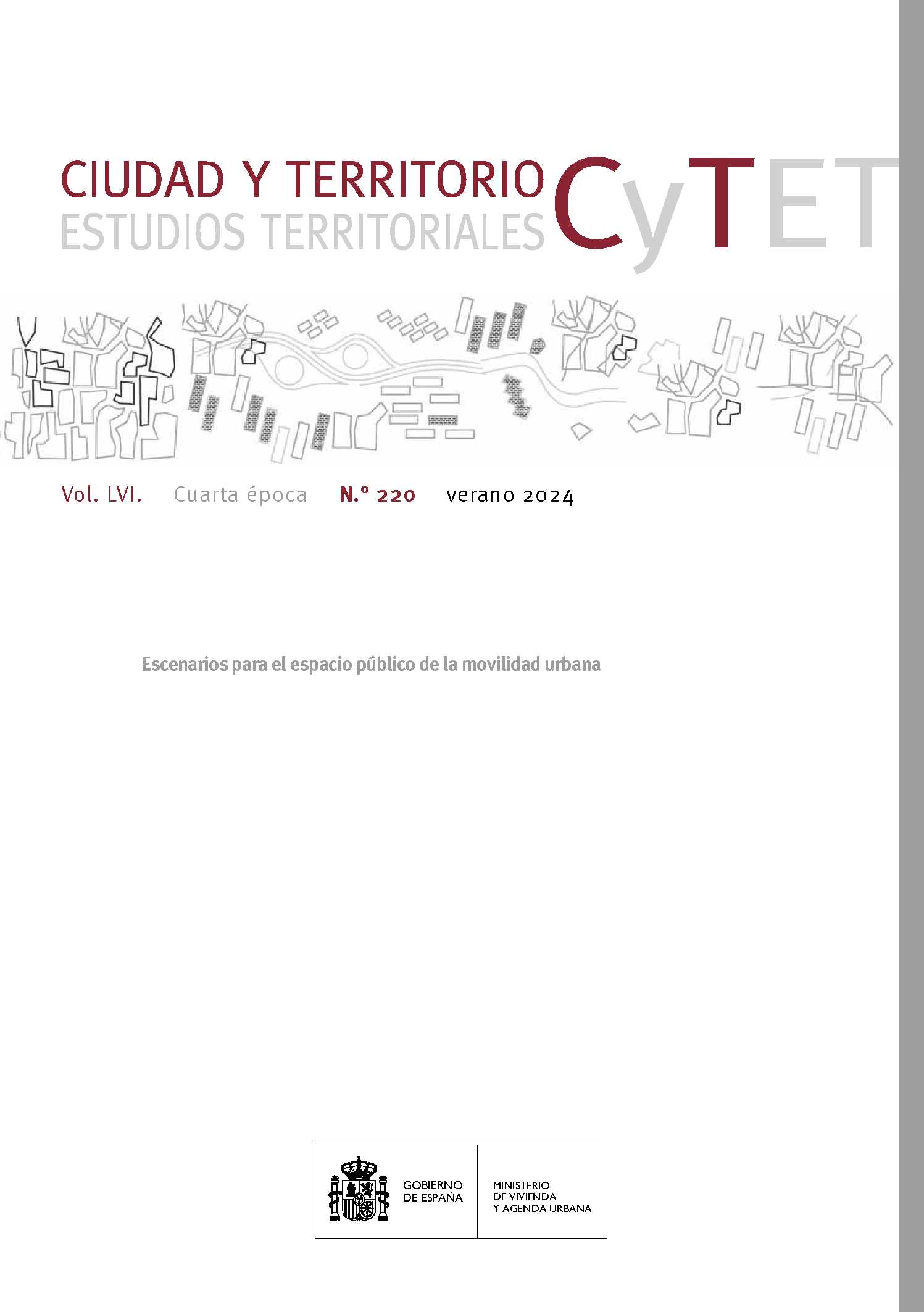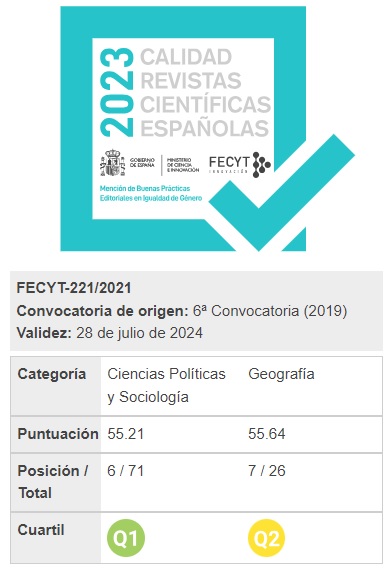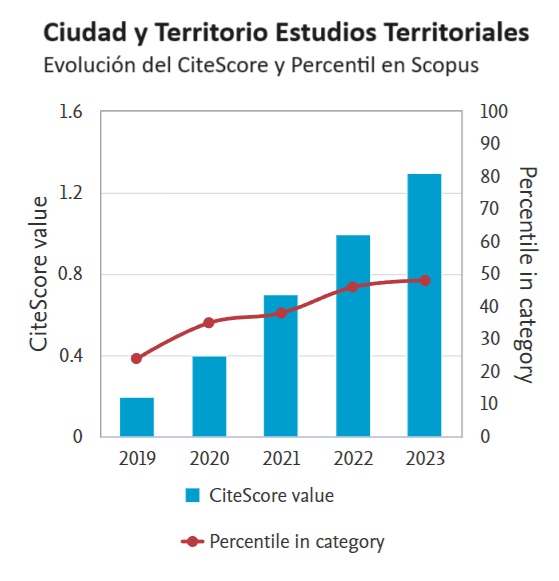Proximity and Planning Tools in Spanish: the cases of Barcelona, Castelló de la Plana, Pontevedra, Valladolid and Vitoria-Gasteiz
DOI:
https://doi.org/10.37230/CyTET.2024.220.17Keywords:
Sustainable mobility, Urban Planning, City of proximity, Public space, Spanish Urban AgendaAbstract
This study analyses the policies related to the proximity city in Barcelona, Castelló de la Plana, Pontevedra, Valladolid and Vitoria-Gasteiz (Spain) in order to identify how they have incorporated this principle into their plans, strategies and actions and understand the values and limitations of each type of plan (Spanish Urban Agenda, Land Use Plan, SUMP; etc.). After a structured analysis of the adopted documents, several elements with great potential stand out: the use of a new spatial unit, the superilla, with a communicative power comparable to that of the 15-minute city in Paris, and also a new area for concentrating development actions in the consolidated city; a large number of actions in each plan covering the four axes of proximity (accessibility, land use, public space and participation); and the potential of the Spanish Urban Agenda as a tool for mobility-urban planning integration.
Downloads
References
ABDELFATTAH, L. & DEPONTE, D. & FOSSA, G. (2022): The 15-minute city: Interpreting the model to bring out urban resiliencies. Transportation Research Procedia, 60, 330-337. https://doi.org/10.1016/j.trpro.2021.12.043
AGENDA URBANA ESPAÑOLA. (2016): ¿Qué es la Agenda Urbana Española? https://www.aue.gob.es/que-es-la-aue#inicio
AJUNTAMENT DE BARCELONA (2014, octubre): Pla de Mobilitat Urbana de Barcelona PMU 2013-2018. https://ajuntament.barcelona.cat/ecologiaurbana/sites/default/files/PMU_Sintesi_Catala.pdf
AJUNTAMENT DE BARCELONA (2015a): Pla de Mobilitat Urbana de Barcelona 2013-2018. Proposta de desenvolupament d’Actuacions. https://bcnroc.ajuntament.barcelona.cat/jspui/handle/11703/85164
AJUNTAMENT DE BARCELONA (2015b): Pla de Barris Barcelona 2015-2023. https://bcnroc.ajuntament.barcelona.cat/jspui/bitstream/11703/128361/5/PLADEBARRIS-pel-dret-de-tothom-a-la-ciutat.pdf
AJUNTAMENT DE BARCELONA (2021a): Superilla Barcelona—Model Eix Verd. El nou carrer del segle XXI. https://ajuntament.barcelona.cat/superilles/sites/default/files/SuperillaBarcelona_Presentacio_CarrerSegleXXI.pdf
AJUNTAMENT DE BARCELONA (2021b, octubre): Medida de gobierno Superilla Barcelona para regenerar Barcelona y sus barrios. https://bcnroc.ajuntament.barcelona.cat/jspui/bitstream/11703/126249/1/Llibret_SUPERILLA_MdG_A4_ES_web%20%282%29.pdf
AJUNTAMENT DE BARCELONA (2022): Pla de Mobilitat Urbana 2024. https://bcnroc.ajuntament.barcelona.cat/jspui/bitstream/11703/128157/1/Pla%20de%20Mobilitat%20Urbana_bcn_2024.pdf
AJUNTAMENT DE CASTELLÓ (2020a): Agenda Urbana de Castelló 2030—Un nuevo modelo de ciudad inclusivo, resiliente y sostenible. https://agendaurbana.castello.es/
AJUNTAMENT DE CASTELLÓ (2020b, noviembre 13): Agenda Urbana Española—Agenda Urbana de Castelló 2030. https://agendaurbana.castello.es/agenda-urbana-castello-2030/agenda-urbana-espanola/
AJUNTAMENT DE CASTELLÓ (2022a): Formulación Estratégica. https://agendaurbana.castello.es/documentacion/?wpdmc=formulacion-estrategica#
AJUNTAMENT DE CASTELLÓ (2022b): Formulación Estratégica—Resumen ejecutivo. https://agendaurbana.castello.es/documentacion/?wpdmc=formulacion-estrategica#
AJUNTAMENT DE CASTELLÓ (2022c): Plan de acción—Agenda Urbana Castelló. https://agendaurbana.castello.es/documentacion/#
AJUNTAMENT DE CASTELLÓ (Director). (2022d): Decidim Castelló. Campaña de Proceso Participativo 2023. https://www.youtube.com/watch?v=7uT-hKWT_C8
AJUNTAMENT DE CASTELLÓ (2022e): Diagnóstico Integrado—Agenda Urbana Castelló. https://agendaurbana.castello.es/documentacion/#
AJUNTAMENT DE CASTELLÓ (2022f, junio 4): CASTELLÓ INFORMA Y FORMA EN MATERIA URBANA - Agenda Urbana de Castelló 2030. https://agendaurbana.castello.es/ficha/castello-informa-y-forma-en-materia-urbana/
AJUNTAMENT DE CASTELLÓ (2022g, junio 8): CASTELLÓ TURISMO SOSTENIBLE - Agenda Urbana de Castelló 2030. https://agendaurbana.castello.es/ficha/castello-turismo-sostenible/
AJUNTAMENT DE CASTELLÓ (2022h, junio 9): CENTRO DE ENVEJECIMIENTO ACTIVO Y SALUDABLE (CEAS)—Agenda Urbana de Castelló 2030. https://agendaurbana.castello.es/ficha/centro-de-envejecimiento-activo-y-saludable-ceas/
AJUNTAMENT DE CASTELLÓ (2022i, junio 12): ESTRATEGIA DE SUPERMANZANAS Y ZONAS DE BAJAS EMISIONES - Agenda Urbana de Castelló 2030. https://agendaurbana.castello.es/ficha/estrategia-de-supermanzanas-y-zonas-de-bajas-emisiones/
AJUNTAMENT DE CASTELLÓ (2022j, junio 16): ESTRATEGIA DE RENATURALIZACIÓN MUNICIPAL Y RESTAURACIÓN ECOLÓGICA - Agenda Urbana de Castelló 2030. https://agendaurbana.castello.es/ficha/estrategia-de-renaturalizacion-municipal-y-restauracion-ecologica/
AJUNTAMENT DE CASTELLÓ (Director). (2022k, junio 20): Agenda Urbana de Castelló 2030. https://www.youtube.com/watch?v=ID2TMmmJ5Dg
AJUNTAMENT DE CASTELLÓ (Director). (2022l, junio 21): Un plan de acción para afrontar la sostenibilidad del futuro. https://www.youtube.com/watch?v=3RSL810gvCA
ANDRES DUANY, R. S. (2021, febrero 8): Defining the 15-minute city [Text]. CNU. https://www.cnu.org/publicsquare/2021/02/08/defining-15-minute-city
APPLEYARD, D. & GERSON, M. S. & LINTELL, M. (1981): Livable streets. University of California Press.
ÁREA METROPOLITANA DE BARCELONA. (2011): Pla d’actuació metropolità (PAM)—AMB. AMB. https://www.amb.cat/web/amb/govern-metropolita/accio-de-govern/pla-d-actuacio-metropolita-pam-
AUDIRAC, I. & SHERMYEN, A. H. (1994): An Evaluation of Neotraditional Design’s Social Prescription: Postmodern Placebo or Remedy for Suburban Malaise? Journal of Planning Education and Research, 13(3), 161-173. https://doi.org/10.1177/0739456X9401300301
AYUNTAMIENTO DE VITORIA-GASTEIZ. (2022a): Plan de Movilidad Sostenible y Espacio Público de Vitoria-Gasteiz (2021-2025). https://www.vitoria-gasteiz.org/docs/wb021/contenidosEstaticos/adjuntos/es/45/92/94592.pdf
AYUNTAMIENTO DE VITORIA-GASTEIZ (2022b): Historia—Plan de Movilidad Sostenible y Espacio Público (PMSEP). https://www.vitoria-gasteiz.org/wb021/was/contenidoAction.do?idioma=es&uid=1040577b_11ad7b633e2__7fc9
BAKER, N. & WEEDON, A. (2023, febrero 26): What is the «15-minute city» conspiracy theory? ABC News. https://www.abc.net.au/news/2023-02-27/the-15-minute-city-conspiracy/102015446
BATTY, M. (2009): Accessibility: In Search of a Unified Theory. Environment and Planning B: Planning and Design, 36, 191-194. https://doi.org/10.1068/b3602ed
BOSCHMA, R. (2005): Proximity and Innovation: A Critical Assessment. Regional Studies, 39(1), 61-74. https://doi.org/10.1080/0034340052000320887
BRUNTLETT, M. (2022): The 15-Minute City: A Feminist Utopia? Transformative Urban Mobility Initiative (TUMI). https://www.transformative-mobility.org/wp-content/uploads/2023/03/TUMI_WMW_Feminism_and_the15min_City-TZGmSO.pdf
BÜTTNER, B. & SEISENBERGER, S. & BAQUERO LARRIVA, M. T. & RIVAS DE GANTE, HAXHIJA, S. & RAMIREZ SAIZ, A. & MCCORMICK, B. (2022): ±15-Minute City: Human-Centred Planning in Action (#9). https://www.eiturbanmobility.eu/wp-content/uploads/2022/11/EIT-UrbanMobilityNext9_15-min-City_144dpi.pdf
CALTHORPE, P. (1997): The Next American Metropolis: Ecology, Community, and the American Dream.
CARPIO-PINEDO, J. & BENITO-MORENO, M. & LAMÍQUIZ-DAUDÉN, P. J. (2021): Beyond land use mix, walkable trips. An approach based on parcel-level land use data and network analysis. Journal of Maps, 17(1), 23-30.
CONCELLO DE PONTEVEDRA. (2012): Haz tu propio Metrominuto. Red de Ciudades que Caminan. https://ciudadesquecaminan.org/wp-content/uploads/2021/08/GuiaMetrominuto.pdf
CONCELLO DE PONTEVEDRA. (1989): PXOU e modificacións realizadas. Concello de Pontevedra. https://www.pontevedra.gal/areas/urbanismo-e-territorio/planeamento-urbanistico/pxou-e-modificacions-realizadas/
CONCELLO DE PONTEVEDRA. (2022a): Agenda Urbana Pontevedra. Marco Estratégico y Plan de Acción. https://axendaurbana.pontevedra.gal/wp-content/uploads/2022/09/18_Marco_estrategico_PA_AUP.pdf
CONCELLO DE PONTEVEDRA. (2022b): Plan de Mobilidade Urbana Sostible. https://sede.pontevedra.gal/public/publications/list/inforpubli/INFPUB/details/161852916
CONCELLO DE PONTEVEDRA & Red de Ciudades que Caminan, RCqC (2015): Haz tu propio Metrominuto.
DE LA CRUZ-MERA, Á. (2019): La Agenda Urbana Española. Ciudad y Territorio Estudios Territoriales (CyTET), 675-686.
ECHEBARRÍA MIGUEL, C. & AGUADO MORALEJO, I. (2003): La Agenda Local 21 como instrumento de sostenibilidad: La experiencia española (*). Estudios Agrosociales y Pesqueros, 199, 61-91.
El País (Director). (2018, junio 14): Pontevedra, la ciudad que mejoró su aire al pensar en sus peatones. https://www.youtube.com/watch?v=24O4JWaoHq8
GAINZA, X. & ETXANO, I. (2014): Mobility planning in vitoria-gasteiz: Innovative actions versus structural limitations. Lurralde: Investigacion y Espacio, 37, 145-168. https://www.researchgate.net/profile/Iker-Etxano/publication/286136192_Mobility_planning_in_vitoria-gasteiz_Innovative_actions_versus_structural_limitations/links/57849e1d08aee45b8443b504/Mobility-planning-in-vitoria-gasteiz-Innovative-actions-versus-structural-limitations.pdf
GARCÍA MARTÍN, F. (2012): Densificación con criterios de soleamiento. Un método gráfico para el cálculo de areas adecuadas para nueva edificación en entornos construidos en el caso de Zabalgana en Vitoria-Gasteiz.
GEURS, K. T. & VAN WEE, B. (2004): Accessibility evaluation of land-use and transport strategies: Review and research directions. Journal of Transport Geography, 12(2), 127-140. https://doi.org/10.1016/j.jtrangeo.2003.10.005
GIL SOLÁ, A. & VILHELMSON, B. (2019): Negotiating Proximity in Sustainable Urban Planning: A Swedish Case. Sustainability. 2019; 11(1):31. https://doi.org/10.3390/su11010031
HANDY, S. L. & NIEMEIER, D. A. (1997): Measuring Accessibility: An Exploration of Issues and Alternatives. Environment and Planning A: Economy and Space, 29(7), 1175-1194. https://doi.org/10.1068/a291175
HERNÁNDEZ AJA, A. (2000): Barrios y equipamientos públicos, esencia del proyecto democrático de la ciudad. Documentación Social, 119. https://oa.upm.es/14232/1/2000_Agust%C3%ADn_Hernandez_Documentacion_social_119_Barrios_y_Equipamientos_Publicos.pdf
HERNÁNDEZ AJA, A & ALGUACIL GÓMEZ, J. & MEDINA DEL RÍO, M. & MORENO CABALLERO, C. (1997): La ciudad estructurada. La ciudad de los ciudadanos. Ciudades para un Futuro más Sostenible. http://habitat.aq.upm.es/aciudad/lista_1.html
HERNÁNDEZ-PARTAL, S. (2020): Los instrumentos de Planeamiento Urbanístico en España: Estudio comparado (I). Ciudad y Territorio Estudios Territoriales, 52(205), Article 205. https://doi.org/10.37230/CyTET.2020.205.11
HULL, A. & PAPA, E. & SILVA, C. & JOUTSINIEMI, A. (2012): Accessibility Instruments for Planning Practice in Europe. Results of the Accessibility Instrument Survey of COST Action TU1002. https://doi.org/10.13140/RG.2.1.1868.3605
INSTITUTO PARA LA DIVERSIFICACIÓN Y AHORRO DE LA ENERGÍA. (2006): Guía práctica para la elaboración e implantación de Planes de Movilidad Urbana Sostenible—PMUS. https://www.idae.es/sites/default/files/documentos/publicaciones_idae/documentos_10251_guia_pmus_06_2735e0c1.pdf
INSTITUTO PARA LA DIVERSIFICACIÓN Y AHORRO DE LA ENERGÍA. (2020): 10 reglas de oro para la realización de un correcto PMUS. IDAE Movilidad Sostenible. https://www.idae.es/movilidad-sostenible/10-reglas-de-oro-para-la-realizacion-de-un-correcto-pmus
JIAO, J. & HE, S. & ZENG, X. (2019): An investigation into European car-free development models as an opportunity to improve the environmental sustainability in cities: The case of Pontevedra. En Papers of Canadian International Conference on Humanities & Social Sciences 2019 (pp. 84-91). https://uniqueca.com/archives/proceedings/Papers%20HUSO2019%20.pdf#page=84
LAMÍQUIZ DAUDÉN, P. J. & CARPIO-PINEDO, J. & BENITO-MORENO, M. (2022): Genealogía de la ciudad de 15 minutos: Aproximación a los conceptos. Cuadernos de Investigación Urbanística, 142, Article 142. https://doi.org/10.20868/ciur.2022.142.4885
MARDONES-FERNÁNDEZ DE VALDERRAMA, N. & LUQUE VALDIVIA, J. & ASEGUINOLAZA BRAGA, I. (2020): La ciudad del cuarto de hora, ¿una solución sostenible para la ciudad post-COVID-19? Ciudad y Territorio Estudios Territoriales (CyTET), LII(no 205), 653-664. https://doi.org/10.37230/CyTET
MARÍN-COTS, P. (2019): La Agenda Urbana 2050 de Málaga. Ciudad y Territorio Estudios Territoriales, 51(202), Article 202.
MARÍN-COTS, P. & PALOMARES-PASTOR, M. (2020): En un entorno de 15 minutos. Hacia la Ciudad de Proximidad, y su relación con el Covid-19 y la Crisis Climática: El caso de Málaga. Ciudad y Territorio Estudios Territoriales (CyTET), Páginas 685-700. https://doi.org/10.37230/CyTET.2020.205.13.3
MARQUET, O. & BEDOYA, V. R. & & MIRALLES-GUASCH, C. (2017): Local accessibility inequalities and willingness to walk in Latin-American cities: Findings from Medellín, Colombia. International Journal of Sustainable Transportation, 11(3), 186-196. https://doi.org/10.1080/15568318.2016.1230804
MATILLA, X. (2022, octubre 25): Barcelona. Implementación de supermanzanas, tráfico y aparcamiento. II Foro “15 Minute City and Health”// Bloque II: Intervención en barrios 15 minutos. https://www.youtube.com/watch?v=5OI55eR5nKQ
MINISTERIO DE TRANSPORTES, MOVILIDAD Y AGENDA URBANA. (2019): Marco Estratégico—Agenda Urbana Española. https://cdn.mitma.gob.es/portal-web-drupal/AUE/03_doc._introduccion_me.pdf
MIRALLES-GUASCH, C. & SARDÀ, O. M. (2013): Dinámicas de proximidad en ciudades multifuncionales. Ciudad y Territorio Estudios Territoriales, 501-510.
MORENO, C. & ALLAM, Z. & CHABAUD, D. & GALL, C. & PRATLONG, F. (2021): Introducing the “15-Minute City”: Sustainability, Resilience and Place Identity in Future Post-Pandemic Cities. Smart Cities, 4(1), Article 1. https://doi.org/10.3390/smartcities4010006
MORENO, C. & GARNIER, M. M. (2020): Livbre Blanc N° 2: La ville du 1/4 d'heure, du concept à la mise en oeuvre (Doctoral dissertation, Université Paris1 Panthéon Sorbonne-IAE). https://hal.science/hal-03763718/document
MUELLER, N. & ROJAS-RUEDA, D. & KHREIS, H. & CIRACH, M. & ANDRES, D. & BALLESTER, J. & BARTOLL, X. & DAHER, C. & DELUCA, A. & ECHAVE, C. & MILA, C. & MARQUEZ, S. & PALOU, J. & PEREZ, K. & TONNE, C. & STEVENSON, M. & RUEDA, S. & NIEUWENHUIJSEN, M. (2020): Changing the urban design of cities for health: The superblock model. Environment International, 134, 105132. https://doi.org/10.1016/j.envint.2019.105132
OBSERVATORIO DE TRANSPORTE. (2019): 5.1 Planes de Movilidad Urbana Sostenible y Planes de Transporte al Trabajo. Ministerio de Transportes, Movilidad y Agenda Urbana. https://observatoriotransporte.mitma.gob.es/monografico/movilidad_ciudades_sxxi/5tendencias-medidas-y-buenaspracticas-en-el-ambito-de-la-movilidad-metropolitana/51-planes-de-movilidad-urbana-sostenible-y-planes-de-transporte-al-trabajo
ORGANIZACIÓN NACIONES UNIDAS. (2016): Nueva Agenda Urbana. Conferencia de las Naciones Unidas sobre la Vivienda y el Desarrollo Urbano Sostenible (Hábitat III). https://habitat3.org/wp-content/uploads/NUA-Spanish.pdf
PADDISON, L. (2023, febrero 26): How «15-minute cities» turned into an international conspiracy theory. CNN. https://www.cnn.com/2023/02/26/world/15-minute-cities-conspiracy-theory-climate-intl/index.html
PARLAMENTO EUROPEO. (2019, marzo 22): Emisiones de CO2 de los coches: Hechos y cifras (infografía). https://www.europarl.europa.eu/news/es/headlines/society/20190313STO31218/emisiones-de-co2-de-los-coches-hechos-y-cifras-infografia
PERRY, C. A. (1929): The Neighbourhood Unit (Vol. 7). Routledge/Thoemmes Press.
PORTO SCHETTINO, M. (2022): Relaciones entre planificación de la movilidad y urbanística. La primera generación de planes de movilidad urbana sostenible y su convergencia con el planeamiento general en ciudades medias españolas (east=-4.8379791; north=39.3260685; name=España) [Phd, E.T.S. Arquitectura (UPM)]. https://oa.upm.es/72213/
POZOUKIDOU, G. & CHATZIYIANNAKI, Z. (2021): 15-Minute City: Decomposing the New Urban Planning Eutopia. Sustainability, 13(2), Article 2. https://doi.org/10.3390/su13020928
POZUETA, J. & LAMÍQUIZ DAUDÉN, F. J. & PORTO SCHETTINO, M. & CENTRO DE ESTUDIOS Y EXPERIMENTACIÓN DE OBRAS PÚBLICAS. (2009): La ciudad paseable: Recomendaciones para la consideración de los peatones en el planeamiento, el diseño urbano y la arquitectura. Centro de Estudios y Experimentación de Obras Públicas.
PROJECT FOR PUBLIC SPACES. (2007): What is Placemaking? https://www.pps.org/article/what-is-placemaking
RAMÍREZ SAIZ. A. & ALONSO, A. & JIMÉNEZ MARTÍN, D. & LAMÍQUIZ, P. (2022): Can Proximal Environments Prevent Social Inequalities Amongst People of All Ages and Abilities? An Integrative Literature Review Approach. Sustainability, 14(19), 12911. https://doi.org/10.3390/su141912911
RAMIREZ SAIZ, A. & JIMÉNEZ MARTÍN, D. & LAMÍQUIZ, P. & ALONSO, A. (2022): The Level of Inclusiveness of Current 15-Minute City Models. A Qualitative Analysis on How Far City of Proximity Strategies and Design for All Are Merging. Transforming our World through Universal Design for Human Development, 297, 288-295. https://doi.org/10.3233/SHTI220851
Redes de Ciudades que Caminan, RCqC. (2020, septiembre 9): Doce claves y un epílogo sobre el modelo Pontevedra. Ciudades que Caminan. https://ciudadesquecaminan.org/blog/cityrepor/doce-claves-y-un-epilogo-sobre-el-modelo-pontevedra/
REID, C. (2023, febrero 8): 15-Minute-City Conspiracy Theories Insane Says 15-Minute-City Creator. Forbes. https://www.forbes.com/sites/carltonreid/2023/02/08/15-minute-city-conspiracy-theories-insane-says-15-minute-city-creator/
SILVA, C. & LARSSON, A. (2018): Challenges for Accessibility Planning and Research in the Context of Sustainable Mobility (International Transport Forum Discussion Papers 2018/07; International Transport Forum Discussion Papers, Vol. 2018/07). https://doi.org/10.1787/8e37f587-en
SILVA, C. & ALTIERI, M. (2022): Is regional accessibility undermining local accessibility? Journal of Transport Geography, 101, 103336. https://doi.org/10.1016/j.jtrangeo.2022.103336
SILVA, C. & BÜTTNER, B. & SEISENBERGER, S. & RAULI, A. (2023): Proximity-centred Accessibility – a conceptual debate involving experts and planning practitioners. Journal of Urban Mobility 4.
SOUTHWORTH, M. (2005): Designing the Walkable City. Journal of Urban Planning and Development, 131(4), 246-257. https://doi.org/10.1061/(ASCE)0733-9488(2005)131:4(246)
STATE GOVERNMENT VICTORIA. (2017): Plan Melbourne 2017-2050. Metropolitan Planning Strategy. https://planmelbourne.vic.gov.au/__data/assets/pdf_file/0007/377206/Plan_Melbourne_2017-2050_Strategy_.pdf
STRAATEMEIER, T. & BERTOLINI, L. (2008): Joint accessibility design: Framework developed with practitioners to integrate land use and transport planning in the Netherlands. Transportation Research Record, 2077. https://doi.org/10.3141/2077-01
Published
How to Cite
Issue
Section
License
Copyright (c) 2024 Patxi J. Lamíquiz-Daudén, María Teresa Baquero-Larriva, Alba Ramirez-Saiz, José Carpio-Pinedo

This work is licensed under a Creative Commons Attribution-NonCommercial-NoDerivatives 4.0 International License.
Considering the provisions of the current legislation on Intellectual Property, and in accordance with them, all authors publishing in CyTET give -in a non-exclusive way and without time limit- to the Ministry of Transport, Mobility and Urban Agenda the rights to disseminate, reproduce, communicate and distribute in any current or future format, on paper or electronic, the original or derived version of their work under a Creative Commons Attribution-NonCommercial-NoDerivative 4.0 license International (CC BY-NC-ND 4.0), as well as to include or assign to third parties the inclusion of its content in national and international indexes, repositories and databases, with reference and recognition in any case of its authorship.
In addition, when sending the work, the author(s) declares that it is an original work in which the sources that have been used are recognized, committing to respect the scientific evidence, to no longer modify the original data and to verify or refute its hypothesis. Author(s) also declare that the essential content of the work has not been previously published nor will it be published in any other publication while it is under evaluation by CyTET; and that it has not been simultaneously sent to another journal.
Authors must sign a Transfer of Rights Form, which will be sent to them from the CyTET Secretariat once the article is accepted for publication.
With the aim of promoting the dissemination of knowledge, CyTET joins the Open Journal Access (OA) movement and delivers all of its content to various national and international indexes, repositories and databases under this protocol; therefore, the submission of a work to be published in the journal presupposes the explicit acceptance by the author of this distribution method.
Authors are encouraged to reproduce and host their work published in CyTET in institutional repositories, web pages, etc. with the intention of contributing to the improvement of the transfer of knowledge and the citation of said works.








 Enlace a CyTET en Linkedin
Enlace a CyTET en Linkedin